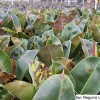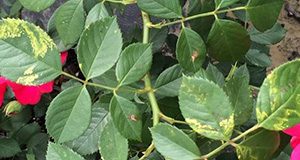Rose mosaic virus disease is one of the most economically important diseases affecting roses, because a single symptomatic leaf can result in the rejection of complete shipments for wholesale or retail rose producers. It continues to be a problem in nursery production and landscapes. This 5-page document discusses the causes, symptoms, and management of this disease. Written by Susannah da Silva, Binoy Babu, Mathews L. Paret, Gary Knox, Fanny Iriarte, Barron Riddle, Matt Orwat, Shawn T. Steed, E. Vanessa Campoverde, and Svetlana Y. Folimonova and published by the UF/IFAS Plant Pathology Department, August 2018.
http://edis.ifas.ufl.edu/pp338
Tag: E. Vanessa Campoverde
Herbicidas Postemergentes para Uso en Ornamentales

This is the Spanish language version of ENH95/WG095 Postemergent Herbicides for Use in Ornamentals http://edis.ifas.ufl.edu/wg059 Postemergent herbicides are applied directly to weeds. This 5-page fact sheet is largely comprised of two tables: Table one lists postemergent herbicides that can be safely used over the top of some ornamentals when used according to label directions; table 2 lists postemergent herbicides that are registered for use around ornamental plants when applied as a directed spray. Written by E. Vanesssa Campoverde, Chris Marble, and Jeffrey G. Norcini and published by the Environmental Horticulture Department.
http://edis.ifas.ufl.edu/ep533
Mancha foliar causada por Xanthomonas en Ficus elastica
 En verano del 2010, en viveros de Homestead se reportaron casos de Ficus elastica con manchas foliares circulares que se asemejan a los síntomas causados por la bacteria fitopatógena Xanthomonas campestris pv fici, aún no reportada en Ficus elastica. El daño severo affectó a la mayoría de los productores comerciales del sur de la Florida. This is the Spanish language version of Bacterial Blight of Ficus elastic Caused by Xanthomonas (PP305). This 3-page fact sheet was written by E. V. Campoverde, A. J. Palmateer, and P. Lopez, and published by the UF Department of Plant Pathology, July 2014.
En verano del 2010, en viveros de Homestead se reportaron casos de Ficus elastica con manchas foliares circulares que se asemejan a los síntomas causados por la bacteria fitopatógena Xanthomonas campestris pv fici, aún no reportada en Ficus elastica. El daño severo affectó a la mayoría de los productores comerciales del sur de la Florida. This is the Spanish language version of Bacterial Blight of Ficus elastic Caused by Xanthomonas (PP305). This 3-page fact sheet was written by E. V. Campoverde, A. J. Palmateer, and P. Lopez, and published by the UF Department of Plant Pathology, July 2014.
http://edis.ifas.ufl.edu/pp312
Bacterial Blight of Ficus elastica Caused by Xanthomonas (PP305)
 In the summer of 2010, leaf blight cases were reported on several Ficus elastica cultivars in Homestead nurseries. Symptoms somewhat resembled those caused by Xanthomonas campestris p.v. fici, but this pathogen has never been reported to occur on Ficus elastica. The outbreak was severe, and the majority of commercial producers in the southern portion of the state were affected. The widespread outbreak from 2010 to date has caused many nurseries to lose entire Ficus elastica crops. This 3-page fact sheet describes the symptoms and disease management recommendations. Written by E. V. Campoverde and A. J. Palmateer, and published by the UF Department of Plant Pathology, April 2013.
In the summer of 2010, leaf blight cases were reported on several Ficus elastica cultivars in Homestead nurseries. Symptoms somewhat resembled those caused by Xanthomonas campestris p.v. fici, but this pathogen has never been reported to occur on Ficus elastica. The outbreak was severe, and the majority of commercial producers in the southern portion of the state were affected. The widespread outbreak from 2010 to date has caused many nurseries to lose entire Ficus elastica crops. This 3-page fact sheet describes the symptoms and disease management recommendations. Written by E. V. Campoverde and A. J. Palmateer, and published by the UF Department of Plant Pathology, April 2013.
http://edis.ifas.ufl.edu/pp305
Well Installation Procedures for Agricultural Irrigation in Miami-Dade County (AE489)
 Water wells or groundwater wells are the main source of irrigation water for agriculture in Miami-Dade County. Depending on the purpose and characteristics of the well, different permits are required for installing the well and pumping water from the well. The information provided in this 4-page fact sheet is based on current rules, contacts, and prices as of March 2012 for Miami-Dade County. Written by Kati W. Migliaccio, E. Vanessa Campoverde, and Ann Marie Superchi, and published by the UF Department of Agricultural and Biological Engineering, June 2012.
Water wells or groundwater wells are the main source of irrigation water for agriculture in Miami-Dade County. Depending on the purpose and characteristics of the well, different permits are required for installing the well and pumping water from the well. The information provided in this 4-page fact sheet is based on current rules, contacts, and prices as of March 2012 for Miami-Dade County. Written by Kati W. Migliaccio, E. Vanessa Campoverde, and Ann Marie Superchi, and published by the UF Department of Agricultural and Biological Engineering, June 2012.
http://edis.ifas.ufl.edu/ae489
